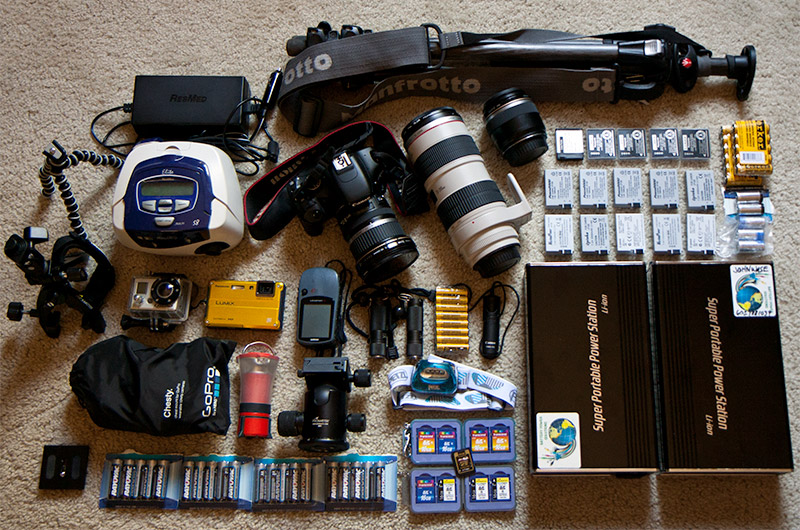
Besides what we need to clothe ourselves on the Colorado River through the Grand Canyon, there is the matter of tools to capture a bit of our 18-day journey and a couple of other essentials. First, the essentials on the right are two lithium-ion power bricks that I hope to get approximately 84 hours of power to run my CPAP, which is the purple and white block next to my camera in the top left of the photo.
Starting on the left are two small tripods; one is the Joby Gorillapod, which may be used for attaching one of the cameras to the dory gunwale, and below that is the ProMaster Clamper Jr., also for attaching to the gunwale for those action shots of us traveling through the rapids. Next to the Clamper is a GoPro HD Hero waterproof camera that will be set to 720p resolution (1280×720 60 fps) for slow-motion playback after our trip. An extra battery and 24GB of memory are set aside for the GoPro; they should allow about 5 hours battery use and 3 hours 15 minutes of video recording or about 11 minutes per day. This camera will be used for recording the rapids almost exclusively.
The next camera is a Panasonic Lumix DMC-TS2 waterproof/shockproof 14mp camera that also records 720p Hi-Def video. For it, we have five batteries and 48GB of memory cards. The Lumix is Caroline’s camera and will be used for video shots from the gunwale but will also be used for stills and, knowing Caroline, more than a few macro photos. Upon writing this, I calculated battery life and memory requirements and decided to order at least one more battery for Caroline.
The third camera we are bringing is my Canon T2i 18mp DSLR. Three lenses are also coming with a Canon 10-22mm EF-S wide-angle, the Canon 70-200mm 2.8 L IS USM telephoto, and a Canon 60mm macro. I’ll have 144GB of memory, allowing me to shoot nearly 5,000 raw images or about 275 per day; this might be too limiting, so I have contingency plans to shoot jpeg images in the middle of the day under full sunlight if I find I want to shoot more. Eleven battery packs have been bought for the Canon to guarantee I do not run out of power before the end of the 18 days. And no, I have not found a reasonable solar solution to deal with recharging batteries when available daylight in the fall is in short supply and is made all the worse by being deep within the canyon. I’m also taking the Canon RS60-E3 wired shutter remote; we have a full moon occurring during our trip, so I think it might be a good idea to be prepared to attempt a few bulb shots for the stars and Milky Way overhead, too.
Other accessories include my Manfrotto 190CXPro3 carbon fiber lightweight tripod with a ProMaster Superlite Ball Head 3. For the GoPro, we also have the Chesty chest harness for attaching the camera just below my chin for a different perspective while we go through the rapids. Our well-worn Garmin Legend C e-Trex GPS will hopefully capture a few of the tracks from the trails we’ll be hiking, and if we have a signal in the depths of it all, we’ll put down waypoints for our camping sites and the end of trails for photo reference after returning home. For lighting, we are bringing 2 LED flashlights, a Petzl 4 LED headlamp, and a Black Diamond 45-watt equivalent LED lantern.
It has been a difficult slog learning how to handle sleeping 17 nights off-grid without requiring moving hundreds of pounds of marine batteries for my CPAP in and out of the canyon. After our trip, I’ll be posting a full review of how the two 9-pound batteries performed.
Finally, the CPAP equipment, 2 of the lenses, the memory cards, spare batteries, and my writing materials are all being locked into a Pelican 1550 waterproof case measuring 18.4x14x7.6 and then lashed to the supply boat, where hopefully it will remain safe and dry.